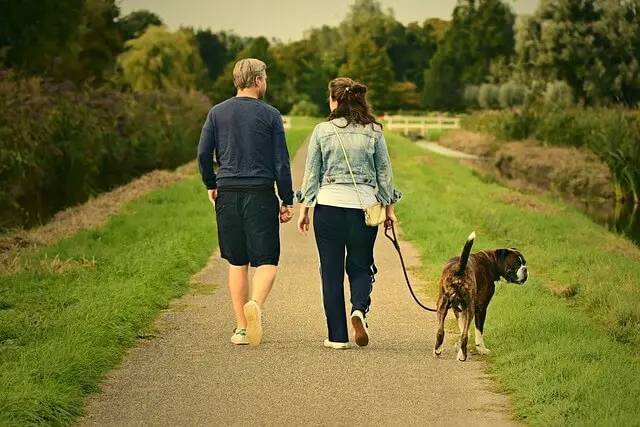How Often Do You Walk Your Dog?
26.05.2021.
One of the things future dog owners need to prepare themselves for is dog walks. If you haven’t had a dog before, one of the first questions you might ask yourself is, “How often should I walk my dog?” The answer to this question will depend on what breed of dog you are getting. Most dog breeds are in the category of 3 walks a day. Here is what you should know about dog walking frequency and intensity.
How often should I walk my dog?
Dogs need walks and physical activity to stay healthy and in shape. Unlike us, they can’t use a bathroom, but they can let you know when they need a bathroom break. There is a difference between long walks and short potty breaks, and you should get to know your dog and understand their needs. All dogs are different, and some might need more walks than others. Plus, dogs will require different amount of walks in various stages of their life.
Puppy walks
When you get a puppy, you should know they need more bathroom breaks and walks. They are still discovering the world around them and learning things adult dogs know. One of the first things you need to teach our puppy is where to go to their bathroom breaks. Accidents are common when puppies are in potty training, so don’t get discouraged if they have an accident in the house. You can read more about potty training here - Potty training.

Puppies need a lot of walks and potty breaks. You can think about it like this - one hour for every month. That means that a 3-month-old puppy can hold it for 3 hours. Take your puppy for regular walks and make sure they learn where to do their business.
Adult dog walks
When your dog reaches adulthood, they should know everything there is about their bathroom breaks. Most adult dogs should go for 3 walks a day minimum. One walk in the morning when the dog slept through the night and their bladder is full. Just like humans, dogs need to go to the bathroom in the morning, so make sure you take your dog out when you wake up.
The second walk is in the middle of the day, and typically, a short potty break is enough. The third walk should be before dinner. This one should be the longest, and you should give your adult dog enough time to explore, run, and have a potty break. This is enough for most dog breeds, and if you keep that schedule, your dog will be more than happy. You can take them out for a short potty break before bed. You don’t want your dog struggling during the night.

Senior dog walks
The older the dog gets, the more walks they will need. Perhaps “walks” is not the correct term - they will need more potty breaks. Just like puppies, senior dogs can’t hold it as long as adult dogs can. However, letting your senior dog in the yard will be more than enough. Keep in mind that they will still need the basic 3 walks a day - morning, midday, and afternoon. They just might need more potty breaks during the day.
Senior dogs will need walks that are not as intense as the walks an adult dog will need. Senior dogs have less energy and weaker joints and muscles, so make sure you don’t overdo it with their walks. They will start enjoying being at home more than walking or running in the park.
How often should you walk different breeds?
There are many different dog breeds in the world, and they all have different energy levels, preferences, and needs. Your dog’s energy levels will determine their needs. High-energy dogs will need more walks. The biggest issue with energetic dogs is that they will become disruptive and destructive if their needs are unmet. Plain old walking will not be enough; they will need active playtime and usually plenty of training.

Energetic dogs like Belgian Malinois, Border Collies, or Fox Terriers will need vigorous training sessions. They have plenty of energy that needs to be spent productively. If you fail to provide them with a healthy outlet, they can start destroying furniture, excessively bark, and they will do anything to alleviate boredom. That doesn’t mean they are bad dogs; that only means they have too much cooped-up energy. As soon as you provide them with enough activities, your dog will stop misbehaving.
Companion dogs and giant dog breeds are usually not that active. Breeds like the Maltese, Shih Tzu, Mastiff, Great Dane, or Newfoundland will function perfectly on two walks a day. They will need two 15-20 minute walks in the evening and afternoon and a short potty break during the day. These breeds are not very active, and their favorite activity is napping.
Benefits
Dog owners can be unaware of all the benefits they get from dog walks. Walking can do wonders for your health, and having a regular walking schedule with your dog will do you both good. Walking will help you lose weight or keep it in check. It will keep your muscles and joints healthy. Another thing dog owners don’t realize is that walking will keep your digestion regular and healthy. You can read more about all the benefits of dog walking here - Dog walking benefits.

In conclusion
The exact dog walking schedule will be determined by your dog. You have to adapt to their needs and your schedule. Make sure you keep an eye on them and notice how often they need to go for a walk. If you have an energetic breed like the Australian Shepherd, you might need to go for long walks and provide them with plenty of physical activity. If you have a lazy breed like the Greyhound, you will need to provide them with two walks and a potty break.
World Dog Finder team







Share